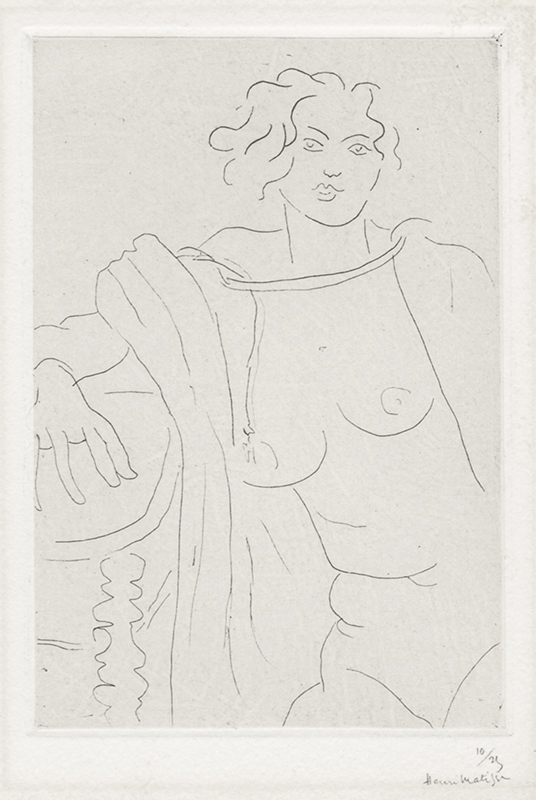Figure assise, le bras droit appuye sur une table is an etching printed chine collé created in 1929 by French artists Henri Matisse. It is pencil signed and editioned 10/25. The reference for this work is Duthuit 215. It was printed by the artist on China paper that is supported on sheet of Arches wove. The platemark measures 7-1/8 x 4-3/4 inches.
William S. Lieberman, in his introduction for the catalog “Etchings by Matisse” for the Museum of Modern Art, New York wrote: “Matisse first worked on copper some time about 1903. His early prints are tentative essays,…in the nature of sketches. His first etchings, cumulatively significant as a series, were begun in 1914 when he produced some fifty etchings. During the following years and throughout the 1920s, Matisse continued to etch a few plates. Then suddenly at the end of the decade and again within a year, he etched more than 100 plates. These are studies of professional models: nudes, odalisques, girls gazing at goldfish. Again, as in 1914, Matisse worked directly on the plate from the model. Purely for his own personal satisfaction, Matisse plays variations on certain themes…The etchings of 1929 were issued separately, usually in editions of twenty-five proofs although some smaller editions and several trials and artist’s proofs of each plate were also printed.”
Henri Matisse, painter, draughtsman, sculptor, and printmaker, was born to Anna Heloise and Emile Hippolyte Matisse on 31 December 1869 in Le Cateau-Cambrésis, France. He attended secondary school in Saint-Quentin between 1882 and 1987. After a year in Paris studying law, he returned to Saint-Quentin and found employment in a law office. Matisse attended drawing classes at Ecole Quentin-Latour and, in 1890, he began to paint and a year later he abandoned law to become an artist.
In Paris, Matisse studied at the Académie Julian, the École des Arts Décoratifs, and at the atelier of Gustave Moreau at the École des Beaux-Arts. He exhibited four paintings at the Salon de la Société Nationale des Beaux-Arts in 1896 and, as a result, one painting was purchased by the French government and Matisse was elected an associate member of the conservative Salon society. At the turn of the century, Matisse sought the Parisian circles of modern artists and, in 1901, showed for the first time in the Salon des Indépendants. The following year he was included in the newly formed Salon d‘Automne.
In 1905, Matisse and André Derain spent the summer painting at the fishing port Collioure on the Mediterranean. The paintings that resulted were filled with explosive complementary colors applied with spontaneous brushwork. Matisse had found his style but when these painting were on exhibition, the Paris critic Louis Vauxcelles derogatorily labelled the artists les fauves (the wild beasts). Fauvism became the first artistic movement of the twentieth century and Matisse was deemed its leader but the adherence to the strictures of one style held no interest for him. As a result of that exhibition and critical comment, Matisse’s work was purchased by Gertrude Stein and her circle and he was represented by thirteen canvases at the 1913 Armory Show in New York. In 1920, he created the sets and costumes for Serge Diaghilev’s production of the ballet Le Chant du Rossignol.
Matisse dappled in printmaking since his first years in Paris and in the 1930s and 1940s created a number of prints as illustrations for works by Stéphane Mallarmé, Henry de Montherlant, Pierre Reverdy, Charles Baudelaire, Pierre de Ronsard, and Charles d’Orléans.
In 1951, despite ill health, Matisse completed his Chapelle du Rosaire for the Dominican nuns in the Riviera town of Vence. He created stained-glass windows, murals, and designed vestments and liturgical objects. When Matisse’s health prevented him from painting, he fashioned with scissors gouache colored papers into cut-outs (Papiers Découpés) creating a world of plants, animals, figures, and shapes.
Henri Matisse died on 3 November 1954 in Nice, France. Today he is still considered one of the greatest colorists of all time.



